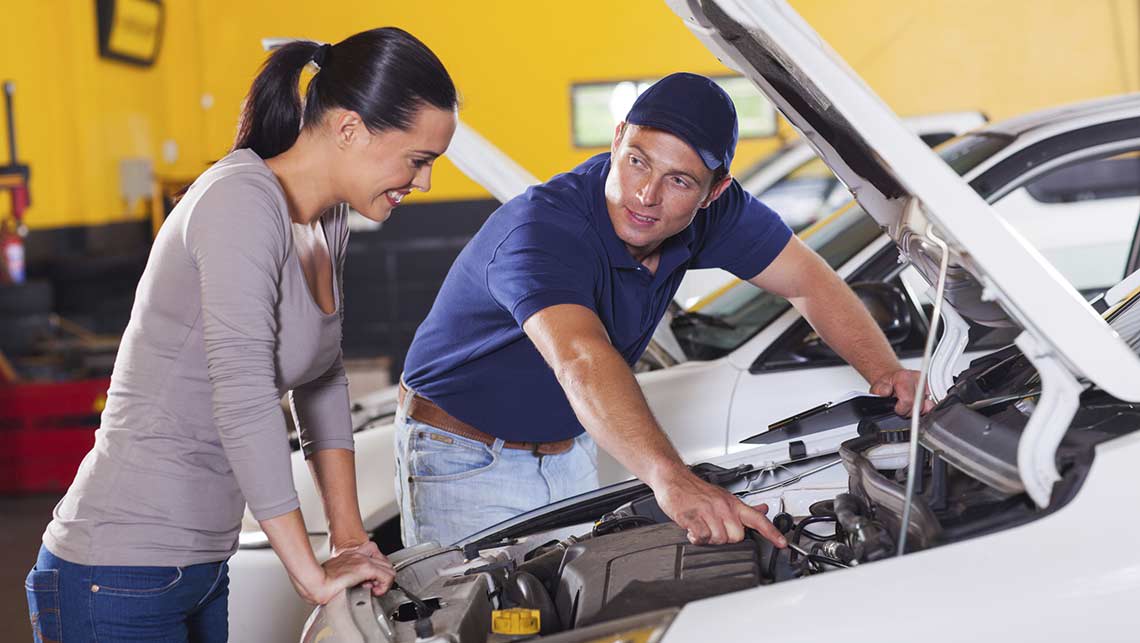Vehicle inspection is crucial, especially if you’re planning to purchase a secondhand car. Bring this comprehensive checklist with you if there isn’t a mechanic available to assist you.
Why do autos need to be checked?
Even pre-owned vehicles should be thoroughly inspected before you lay down any cash. Although purchasing old cars may be more economical, their condition cannot compare to that of new ones. They most likely have unseen issues that can’t be seen at first glance.
It is advisable to properly inspect the vehicle on your own, or better yet, with the assistance of a qualified mechanic, prior to purchase. Only once the car is hoisted up can many underlying issues be discovered. Do not hire any technician; rather, hire one who specializes in that particular brand of cars. And remember to bring along our comprehensive list to check car as below.

A clean-looking car engine may cover potential problems inside
What to do during a diagnostic test for a used car
Major and minor faults are the two main things to check for when assessing a used car. Major issues cannot be negotiated. If you are, get out of the car and look for another one. Minor issues are manageable, but you should consider them during negotiations to get a better offer because fixing them will cost more money.
Examples of serious car problems include the following:
(a) Issues with the engine and transformation
(b) Serious rust
(c) Electric problems
(d) Flooding, etc.
Here are some instances of minor car problems:
(a) Brake problems
(b) Issue with suspension
(c) Dents
(d) Bald tires, etc.
Items you might need for a pre-purchase examination on a used car
You can require a variety of supplies for your pre-purchase inspection of the car, such as:
(a) Flashlight: This is used to illuminate objects so that they may be seen clearly.
(b) Magnet: It is used to find corroded regions that are damaged.
(c) To check the engine oil, use a paper towel.
(d) CD/USB cable: They can be used to test the audio system.
(e) knowledgeable individual: You should bring along a second person who is educated in used car inspection in addition to the mechanic so you can get their perspective.

Steps in the checklist for vehicle inspection
- Quick recall of automotive history
Look first around the car’s exterior to spot anything that doesn’t belong. The presence of several fractures on the body is a sign that there can be additional cracks in concealed areas. Examine the interior’s fixtures as well, including the steering wheel, inner door knobs, and the seats. Are they in decent shape? To see if you’re comfy, take a seat in the driver’s seat. Can you plainly see the road? Are your legs spacious enough?
You can learn a little about the history of the car and all the occurrences it has experienced from these fast looks.
Ask the seller about the car’s history in various ways throughout the inspection to determine if they provide a consistent response or not.
- Cold-start the vehicle
A malfunctioning engine can often be found by cold starting it. Spend some time inspecting the car’s various components. After some time, request that the salesperson start the vehicle. Do you notice any exhaust smoke? How loud is the engine? If it makes a loud noise, don’t bother with the car because this is a sign of a serious issue. An effective engine runs quietly and without crackling.
3. Verify the windscreen
Keep a tight eye on the windshield. Be on the lookout for cracks and other damage, such as chipping. Avert large cracks and chips.

- Examine the body’s exterior.
What does the body panels’ reflection look like? Do you see any differences in the texture of the paint? If so, it’s a sign that the car has had body work done in the past. If you are quite close to the car, you might not see this. To get a better view, step back and observe it from a distance.
Open and shut each door. Do you hear any noises or see any obstacles? Doors need to open quickly. Open the driver’s door and raise it on hinges. Are you observing any freeplay? Not at all, should be. Additionally, avoid driving vehicles that show evidence of heavy use because the transmission may be worn.
- Examine the tires.
Always keep your car’s tires in good shape. Do they appear worn or have any cuts? Be aware of the brand. For safety purposes, all tires must be from the same manufacturer.
Although tires do not last forever, their wear should be uniform. The wheels of the car may not be aligned properly if they are more worn-out inside.

- Examine the inside.
The comfort level of a car is determined by its interior. First, you don’t want to experience any key-related issues. Verify that both key fobs are functioning properly. There are usually two or three key fobs in new autos. Make sure to find out how many the car has from the salesperson.
You will be seated in the automobile seats with your loved ones or other passengers. Make sure they are at ease. Keep an eye out for damages like burn marks and rips.

- Check the power mirrors, locks, and windows
Accessories like power windows, mirrors, locks, and other features are as crucial. Window regulator issues are common in older vehicles. Verify that they can move freely up and down by testing them.
Heated seats in used automobiles frequently have issues, and replacing them may be extremely expensive. Make careful you inspect them to ensure they are in good shape.
Keep a watchful eye on the controls. How does the sound system sound? Is the USB import or CD player in good working order?
- Examine how well the heater and air conditioner are working.
It can be stressful to drive, so you don’t want to be confined to a vehicle with poor ventilation. While the automobile is running, properly inspect the air conditioner. If the room isn’t filled with frigid air, vents quickly enough, it’s a sign that it’s broken.
Next, examine the heater’s fan speed settings. The issue of heater fans only operating at high speed is a common one.
What scent are coming from the vents, too? Burnt oil smell is likely a sign of engine compartment leaks.
- Verify any flood damage
Problems might arise in flooded vehicles. Modern cars have a lot of wireworks underneath them, and when they become wet, these wireworks can cause issues. Keep an eye out for wetness or dampness under the carpet.
If you’re still not convinced, ask for a history report to find out how the vehicle fared during a flood.
- Examine the engine.
You must stop the engine before doing this. Switch to park and engage the parking brake. These are safety measures to avoid casualties.
Look for the following while crawling under the vehicle:
(a) Antifreeze (b) Leaks
(c) Repairs of poor quality
(d) Signs the car hasn’t received routine maintenance
Keep in mind that a clean appearance under the hood does not guarantee that the car is in good shape. Perhaps the salesperson gave it a thorough wash. Make sure a mechanic performs additional examination.
Minor leaks are common in high mileage vehicles and may be signs of more serious issues. To prevent recurring issues, you should search for autos with absolutely no leaking. The only typical leak in a car is the drip of water from an operating AC.
- Check the amount of engine oil

It’s best to let your mechanic handle it if you aren’t up to the task. First, put the parking brake on and switch off the automobile. Find the engine dipstick and remove it. What color is the oil? If it’s unclean, it indicates a lack of upkeep. Lift the oil filler cap, then use a flashlight to peer inside the engine. The condition of the engine is poor if you notice substantial black deposits.
- Examine the transmission oil
Be aware that certain vehicles lack a dipstick for the transmission fluid. Drop a small amount of fluid on a white paper towel if the automobile has one. Looks like what? An excessive amount of transmission wear is indicated if it is really unclean and smells terrible.
Driving test
Having done all the checks, it’s time for a test drive. It’s time for a test drive after all the checks have been completed.
Allow some time. The longer you drive, the more underlying issues are exposed. Long distance driving might cause engine overheating. A manual transmission might also malfunction after 20 to 30 minutes of driving.

While resting while driving, there are several things to watch out for:
Transmission activation
Change the automatic transmission from Park to Drive while the car is stationary and the engine is running. How long does it take for the transmission to engage? If it does, it means there are problems with the transmission.
Taking a city drive
Is there a delay when you accelerate while driving? Do you notice any odd noises when you accelerate or declare? Is the smoke unusual? There shouldn’t be constant smoke, and the sound generated should be smooth.
Taking a city drive
Is there a delay when you accelerate while driving? Do you notice any odd noises when you accelerate or declare? Is the smoke unusual? There shouldn’t be constant smoke, and the sound generated should be smooth.
When stopping, does the car jolt? If so, there are issues with the AWD or transmission.
Driving more quickly on the highway
Is the car steady when you’re traveling on the highway? Is there any sway to one side? If so, there are problems with wheel alignment.
Does the vehicle rattle when you’re moving quickly? If so, it has problems with the wheels and tires.
Do you notice any trembling while applying the brakes? If so, it has twisted or been rusty brake problem.
Post Words
List all problems encountered during the test drive and make the salesman aware of them. Prior to completing a purchase, agree to have any minor issues repaired with the salesman if they are as discussed above.
Ask the salesman about the specific brand(s) they plan to use, and make sure it corresponds with the automobile brand, if they promise to cure the issues or replace any damaged things.
Finally
Before signing the contract, carefully read it and have another person do the same. If you’ve checked off every item on the above checklist, you’re finished!



